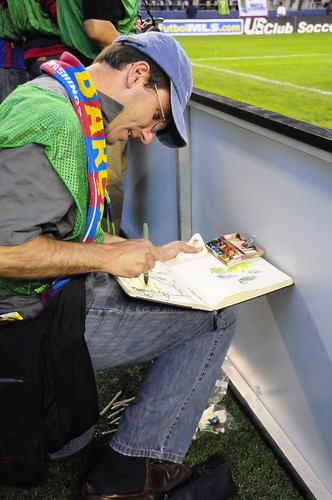 I'm more than a little in awe of Gabi Campanario. His sketches are wonderful--full of feeling, character, atmosphere, and grace, while simultaniously communicating a great deal of detail and narrative.
I'm more than a little in awe of Gabi Campanario. His sketches are wonderful--full of feeling, character, atmosphere, and grace, while simultaniously communicating a great deal of detail and narrative.And his undying energy and enthusiasm have all but singlehandedly turned a bunch of disconnected sketchers into a movement. Simply put, without Gabi there would be plenty of urban sketchers, but there wouldn't be Urban Sketchers.
As well as founding the Urban Sketchers Flickr group, Blog, Non-Profit Organization, and Symposium(s), Gabi's own sketching career has taken off tremendously in recent years. His regular column, Seattle Sketcher, runs in the Seattle Times, and he's become something of a local celebrity, featured several times on local TV and recognized frequently in public.
I'm honored to have the opportunity to interview Gabi for this blog, and I very much look forward to finally meeting him in person at the Symposium in Portland!
Jason: You're a proper professional sketch journalist working for a real newspaper. The idea feels like a throwback to before the rise of photographic reproduction in the late 19th century. But here we are in the internet age, and it works great! Do you feel like a pioneer? Who do you feel are your peers?
 Gabi: I think illustration in general, not just documentary sketches, is an underutilized resource in newspapers. I see newspaper pages full of articles and photography, but how much newsprint is devoted to hand-drawn visual storytelling? The illustrated newspapers of the second half of the 19th century became very popular with readers with full pages of wonderful documentary illustration, but the introduction of photography at the turn of the century pretty much killed the role of artists in the storytelling process.
Gabi: I think illustration in general, not just documentary sketches, is an underutilized resource in newspapers. I see newspaper pages full of articles and photography, but how much newsprint is devoted to hand-drawn visual storytelling? The illustrated newspapers of the second half of the 19th century became very popular with readers with full pages of wonderful documentary illustration, but the introduction of photography at the turn of the century pretty much killed the role of artists in the storytelling process.I hope my little contribution helps us turn back the clock at little bit. In this day and age where Photoshopped imagery is everywhere, I think we are craving for the authenticity of hand-drawn art. When it comes to sketches done on location, the connection a reader can make with the artwork can also be very powerful. Readers of my newspaper column send me emails sharing memories they associate with a location I may have drawn. Not only is the sketch a personal and unique representation of a moment and place, people also react to them in a very personal way. That speaks to their storytelling and communicative qualities.
I am certainly no pioneer in any of this. I may be the only sketcher that I know of on a newspaper staff, but there are amazing illustrators who've done reportage illustration or location sketching for years. I talked to folks like Paul Madonna, Steve Brodner and our own urban sketchers Veronica Lawlor and Walt Taylor for this article on this subject that I wrote for the World Association of Newspapers annual report last year.Jason: Do you find yourself doing things you wouldn't otherwise do to get a sketch? Or is it more a matter of documenting what you'd be up to anyway? Have you been sent out on assignments, or do you pick all your own topics?
Gabi: It's only being a little over a year since I started my newspaper blog and weekly column, so I'm still getting a feel for it. It's harder than I thought. I can't just sketch what I want, write a couple of paragraphs for my blog and be done. I need to aim for timely topics and sketch and interview folks who have a story to tell, getting their first and last names too!
I was sent out to sketch a soccer game. Other than that one, I generate most of the ideas for my blog and column. So far, sketching from a rowing boat and from a fishing boat going at 40 mph are two sketch outings I particularly enjoyed.
Jason: Do you ever feel limited to providing proper information about notable subjects via your sketches, versus just capturing mundane or commonplace situations and views?
Jason: Do you ever feel limited to providing proper information about notable subjects via your sketches, versus just capturing mundane or commonplace situations and views?
Gabi: I continue to capture everyday moments and blog them in my newspaper blog, but not as often as I did before. Now I'm trying to be more "newsy" and get a sense of the local community. For example, in May I sketched a bunch of bike commuters (here, here and here) because it was Bike to Work Month. That's a good example of a timely topic and using sketches to tell a story that affects people's lives.
Jason: Since you founded Urban Sketchers in October of 2008, the growth and interest in the blog has been tremendous, and the organization has gone from an informal collective to a nonprofit corporation. Take us back to the beginning--why did you found Urban Sketchers, and where did you hope it would be two years later?
Gabi: It seems like it was a long time ago, but it's only been a little over a year and a half! Urban Sketchers started in late 2007 as a flickr group as you'll remember because you were among the first contributors there. A year later, the idea of the blog grew out of my interest not just in seeing sketches but in reading about the story behind the sketch. I felt that the blog format would allow for a more narrative, journalistic approach, and would also juxtapose dispatches from cities around the world. I was intrigued by the idea of seeing and reading a blog post from Bangkok after another one from London or Johannesburg.
Jason: Since you founded Urban Sketchers in October of 2008, the growth and interest in the blog has been tremendous, and the organization has gone from an informal collective to a nonprofit corporation. Take us back to the beginning--why did you found Urban Sketchers, and where did you hope it would be two years later?
Gabi: It seems like it was a long time ago, but it's only been a little over a year and a half! Urban Sketchers started in late 2007 as a flickr group as you'll remember because you were among the first contributors there. A year later, the idea of the blog grew out of my interest not just in seeing sketches but in reading about the story behind the sketch. I felt that the blog format would allow for a more narrative, journalistic approach, and would also juxtapose dispatches from cities around the world. I was intrigued by the idea of seeing and reading a blog post from Bangkok after another one from London or Johannesburg.
Having become "digitally acquainted" already with many sketchers via flickr, blogs and sketchcrawl dot com, I thought the idea could work. Did I imagine it would spread so fast? Not really. But I'm not completely surprised because urban sketching is nothing new. It just didn't have an outlet online like Urban Sketchers. The blog, the flickr group and the Facebook page have filled in a void and given everyone an outlet to share our work. While other fabulous sites existed like Sketchcrawl.com or The Sketching Forum, I think our name "urban sketchers" also speaks directly to who we are, not only to what we do. Most of the people who are visiting the site have been urban sketchers for years, they just didn't call themselves that. Now we have a new name to identify ourselves with.
Given the phenomenal response to the blog, I proposed to become a nonprofit because I see a lot of good that can be done through our visual storytelling. As a nonprofit we can raise funds for artists' grants and scholarships and organize educational workshops like this first Symposium. We are not quite there with the artists' grants and scholarships yet but we will get there. There are many stories out there around the world waiting to be drawn. If Urban Sketchers can provide resources so artists can get paid to draw and report those stories, we'd be fulfilling our mission of showing the world, one drawing at a time. We'll continue to do it out of our own generosity, but we can do more sketch journalism if we have financial backing through donations and sponsorships. To make a comparison, Urban Sketchers could become for sketch journalism what National Public Radio (NPR) here in the U.S. is for broadcast journalism. It's a big goal, but I feel we could all make it happen together.
Jason: This summer's Portland event is our most audacious project yet. How did the idea come up for an annual Symposium, and what do you hope comes of it?
Gabi: I was invited to teach with Kurt Hollomon during his regular summer class at PNCA and I took the opportunity to propose a bigger workshop, with more instructors and larger participation, like a sketching workshop I had just attended in Spain called De Vuelta Con el Cuaderno. I suggested the idea to the Urban Sketchers board and we submitted a proposal for the Symposium in December of last year. Seven months later, the workshop will become a reality and we hope it sets the foundation for future events. I can't wait to meet you all in Portland!

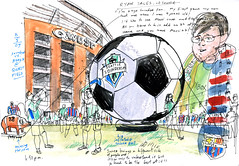
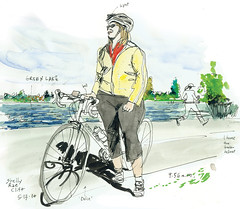
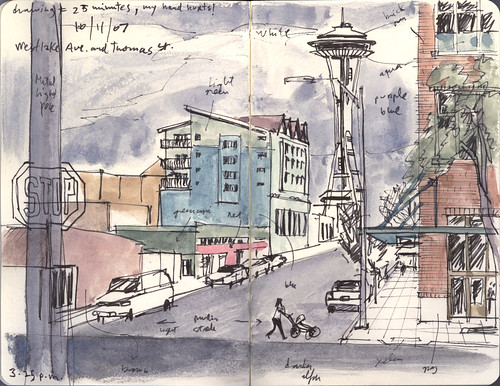
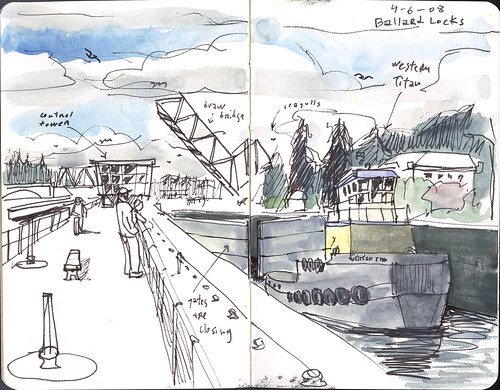
well done, Jason, great interview.
ReplyDeleteWonderful interview Jason! Gabi, I enjoyed reading your thoughts on sketch journalism. Thank you for starting the Urban Sketchers blog and working so hard at it. I share your dream for its potential!
ReplyDeleteYes, i think Urban sketchers help to change many things. I think the hard part its to continue now. The expectations are high.
ReplyDeleteThanks gabi.
Terrific interview. I love Gabi's sketches and look forward to working with him in Portland.
ReplyDeleteWell done, Gabi! Folks in Portland are looking forward to the symposium!
ReplyDeleteGiven the phenomenal response to the blog, I proposed to become a nonprofit because I see a lot of good that can be done through our visual storytelling. As a nonprofit we can raise funds for artists' grants and scholarships and organize educational workshops like this first Symposium. egyptian cotton sheets , best cheap comforter sets We are not quite there with the artists' grants and scholarships yet but we will get there. There are many stories out there around the world waiting to be drawn
ReplyDeletePlenty Thingz is een e-commerce website, hier kun je elk product vinden. Spin, wiebel en race; het kan allemaal met onze kinderauto! Deze wiebelende auto houdt je kind actief en ontwikkelt zijn evenwichts- en coördinatievaardigheden tijdens het spelen. Hier vindt u einhell stofafzuiger.
ReplyDeleteThe Tineco Pure One S12 Black Friday will be examined in depth in this review. Cordless stick vacuums have gone a long way in the previous five years, and this one stands out for its creative design.
ReplyDeleteThe A10 was the first Tineco vacuum I tested, and while it did well in cleaning, it fell short of the Dyson in terms of quality of construction and fit and finish.
The Pure One S12 is the company's greatest product to date in terms of quality and performance, even if they enhanced the quality with the A11 model.
you took interview of the most skill full man he really had a great talent urban sketching is not very easy to do and through your post he is having fame and people are getting knowledge about him but i am a student and searching for the educational blog and for that my cousin suggested me to visit Informal essay topics service to get the most helpful guide.
ReplyDelete